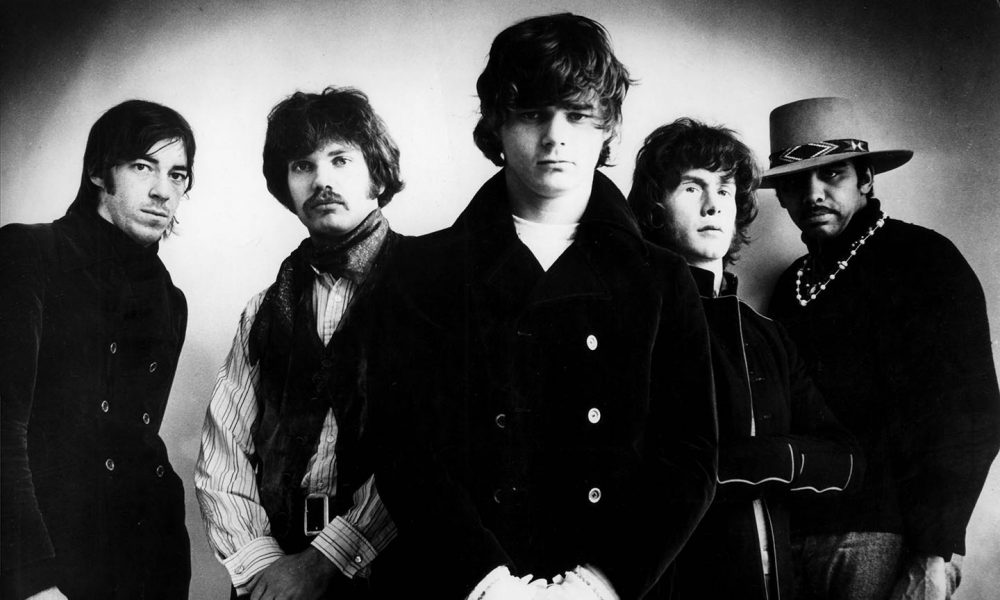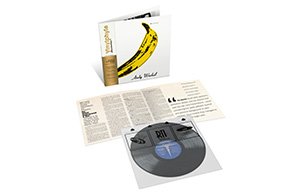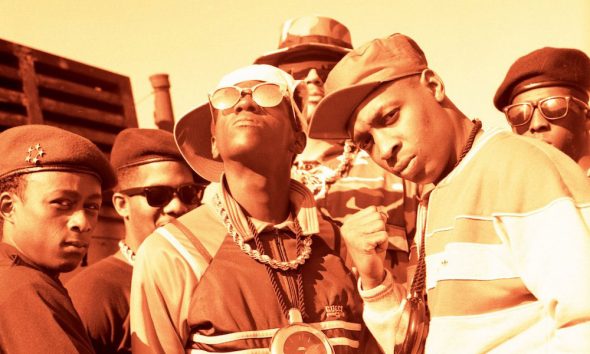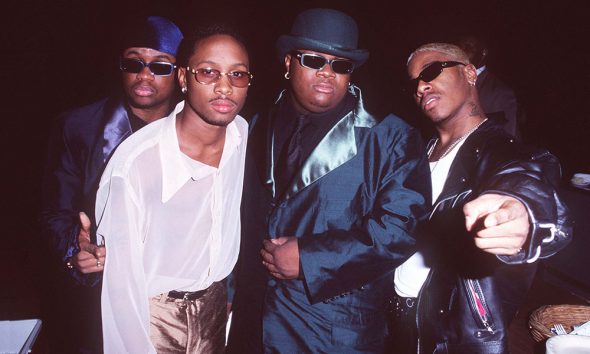Essential Steve Miller Band Guide: The Best Albums, The Must-Hear Tracks
Known primarily for his chart-topping singles, a deeper look into Steve Miller Band’s albums reveal a wide-ranging artist who’s more than a pop virtuoso.

Known primarily for his chart-topping singles “The Joker,” “Fly Like An Eagle” and “Abracadabra,” the larger picture of Steve Miller’s musical contribution can be lost to the casual listener. A deeper look into his body of work, however, reveals an artist who strived to be more than just a pop virtuoso, a feat not to be overlooked. Take the time and you’ll hear a songwriter and musician who was more than capable of riding the wave of history spanning the 60s to today.
Covering his entire studio discography, from 1968-2011, we take a look at Steve Miller’s evolution as an album artist through the best Steve Miller Band albums of every era.
Children Of The Future (1968)
Like many of the best debut albums of the 60s, Children Of The Future is a confluence of influences. Fresh off their appearance at Monterey Pop Festival, Steve Miller Band’s Children Of The Future takes its inspiration from the psychedelic scene that permeated San Francisco, and the lo-fi recordings his father made of early rock’n’roll luminaries Les Paul and T-Bone Walker; it was these men who introduced rock’n’roll boogie to Miller at an early age. Running to 37 minutes of psychedelic blues-rock, Children Of The Future was an impressive debut, with contributions from bandmate Boz Scaggs and storied producer Glyn Johns.
Key track: “In My First Mind”
Sailor (1968)
A wild ride steeped in the British psychedelic scene that birthed it, many Steve Miller Band purists point to Miller’s sophomore effort as their favorite of the group’s early albums. Sailor is as experimental as anything Pink Floyd could have dreamed up during one of their improvisational light shows, yet still retains the attention to detail one comes to expect from Miller. Beginning with the sounds of distant foghorns on the San Francisco Bay, on “Song For Our Ancestors,” the album’s seafaring concept is made clear, but that doesn’t stop Miller from dabbling in doo-wop and R&B, or getting political on the Vietnam-era anthem “Living In The USA.” Sailor retained the same trippy aspects of Miller’s debut album, but marked a shift towards the more concise, pop-focused direction of his future.
Key track: “Living In The USA”
Brave New World (1969)
As 1968 came to a close, Steve Miller Band saw a number of changes in their line-up. Founding members Boz Scaggs and Jim Peterman left the group, while Miller was joined by keyboardist and sometime co-writer Ben Sidran, legendary session pianist Nicky Hopkins and very special guest Paul Ramon (aka Paul McCartney). With an unbeatable roster, Brave New World is pure rock’n’roll incarnate. From the funky bassline of “Celebration Song” to the scorching “My Dark Hour” – featuring McCartney and boasting one of the most commonly ripped-off guitar riffs in all of rock – the album has a newfound rebellious energy the previous ones did not. It also marked the first appearance of Miller’s many personae, the Space Cowboy.
Key track: “My Dark Hour”
Your Saving Grace (1969)
Like the best artists of the era, Steve Miller Band changed with the times, shedding the more psychedelic sounds of the 60s and embracing a more straightforward approach to recording and songwriting as a new era beckoned. Calling Your Saving Grace “soft rock” is too narrow-minded. It is a daydream of an album, effortlessly shifting from one blusey groove to the next, from the gospel-inspired “Don’t Let Nobody Turn You Around” to the funked-out “Little Girl.” Hopkins and Miller join forces on the nearly nine-minute epic “Baby’s House,” featuring one of Miller’s finest vocal performances and a full choir at the finish. With Woodstock in the rearview, Your Saving Grace firmly plotted out the direction Steve Miller Band would boldly go from there on out.
Key Track: “Baby’s House”
Number 5 (1970)
Coming after their bluesy, psychedelic heyday but before their 70s mainstream hits, Number 5 is the lost entry among Steve Miller Band albums. From the opening number, “Good Morning,” to the closing track, “Never Kill Another Man,” each song brings a uniquely 1970 flavor to the table – especially the mariachi-heavy “Hot Chili,” which creates a memorable rock riff using Mexican trumpeters. That said, there are quite a few surprises up Miller’s sleeve: Scaggs returns to co-pen the ZZ Top-inspired “Going To Mexico,” and he enlists Nashville session player Buddy Spicher on fiddle for the country-leaning “Going To The Country.” Like Your Saving Grace, Number 5 is a clear evolutionary step toward the adult contemporary landscape that Miller would dominate towards the end of the decade.
Key track: “Going To The Country”
Rock Love (1971)
Upon its initial release, Rock Love didn’t fare well with critics, but in hindsight it’s a brilliant display of Miller’s guitar chops and live act. The album is made up of two distinct parts: one half is extended studio cuts, while the other was recorded live in Pasadena and Hollywood, Florida. At the time of its release, Miller was still recuperating from a motorcycle accident and most of his regular line-up was missing from the live performances. “The Gangster Is Back” and “Blues Without Blame” are among the impressive live recordings, while “Let Me Serve You” is ballsy 70s rock at its best.
Key track: “Let Me Serve You”
Recall The Beginning… A Journey From Eden (1972)
Following the uneven reception of Rock Love, Miller rebounded with his sixth studio album, Recall The Beginning… A Journey From Eden. The first half of the record is a love fest dedicated to R&B, American folk, and old-fashioned rock’n’roll, while the second half is a fond farewell to the bluesy psychedelic past of early Steve Miller Band albums. It would be the last record before Steve Miller officially broke into the mainstream. In some ways, it also feels like his most personal album – as if listening to someone’s musical adolescence. With the help of some additional string arrangements, Miller shows off his soft side with the touching ballads “Love’s Riddle” and “Nothing Lasts.”
Key track: “Journey From Eden”
The Joker (1973)
The Joker is the sound of a musician in full possession of his powers. From start to finish there’s a confidence that reverberates on each track. Even his guitar playing is more fearless than ever – you can hear it in the way he hits his strings and bends them to bluesy perfection. That’s never more apparent than on his rendition of the Robert Johnson classic “Come On In My Kitchen.” And, of course, there’s the iconic title track that changed the course of Miller’s career. With its earwormy bassline, signature wolf whistle, and undeniable groove, “The Joker” scored Miller his first No.1 hit. The single also serves as a callback to all his previous personae, Maurice, Space Cowboy, and Gangster of Love… but they all get blown away by The Joker.
Key track: “The Joker”
Fly Like An Eagle (1976)
For much of his career, Steve Miller had been recording albums at an impressive clip. Following the success of The Joker and an extensive tour, the band went on hiatus, later regrouping with a new line-up, that retained only Lonnie Turner from The Joker. Unlike on previous Steve Miller Band albums, Fly Like An Eagle follows a more singles-based approach, with half the songs ending up on that album while the others went on 1977’s Book Of Dreams. Stacked with hooks, Fly Like An Eagle would be the beginning of Miller’s FM domination, thanks to the omnipresent hits “Take The Money And Run,” “Rock’n Me” and the title track. Not to be outshined by the hits, Fly Like An Eagle displays all the musical chops Miller had picked up over the course of eight albums, from the psychedelic folk of “Wild Mountain Honey” to straight bluegrass on “Dance, Dance, Dance” and pure popcraft on “Take The Money And Run.”
Key track: “Fly Like An Eagle”
Book Of Dreams (1977)
Book Of Dreams is the absolute peak of 70s cool. It conjures up feathered hair, mirrored sunglasses, and groovy carefree rhythms. But couched in this smooth presentation is Miller’s return to the sonic experimentation of his early 60s work. The album features some of the greatest Miller riffs of all time on songs like “Jet Airliner,” “Swingtown” and “The Stake,” but also takes the listener to places they may not expect, like the trippy “Electrolux Imbroglio” and the folk-inspired “Babes In The Wood.” It debuted at No.2 on the Billboard 200 and went
certified gold just one week after its release.
Key Track: “Jet Airliner”
Circle Of Love (1981)
Some artists have misfires, others have misunderstood works of art that don’t gain the recognition they should; Circle Of Love was the latter. Released during the height of 80s pop decadence, Circle Of Love was one of the most original releases in Miller’s career. Ranging from the beachy soft jam of the opening track, “Heart Like A Wheel,” and ending in the long cut featuring spoken word, “Macho City” – no doubt inspired by the then-burgeoning New Age scene – Circle Of Love is more enigmatic than anything that dominating FM radio at the time.
Key Track: “Heart Like A Wheel”
Abracadabra (1982)
Steve Miller Band’s 12th studio album is so much more than its catchy title track. Abracadabra was the culmination of an artist reaching his middle years and searching for inspiration. Rather than jumping on any bandwagon, the album sees Miller keeping an open ear to new wave and filtering it through the SMB experience. Every song, from the first to the last, is about waiting, longing, searching for… what? That’s the answer, isn’t it? Still searching. The fact that it produced one of the biggest hits of the early 80s was just an added perk.
Key Track: “Abracadabra”
Italian X Rays (1984)
This album works a soundtrack to a film that only exists in the minds of Steve Miller and Tim Davis. It’s funky and – at times – an otherworldly side attraction in what was otherwise a career filled with classic rock standards. But there’s a story behind it. Tim Davis, former member of Steve Miller Band who worked with Miller on drums, songwriting, and vocals for the group’s first five years, was dying from diabetes. Italian X Rays is what happens when two old friends get together for one last good time. Best listened to on a road trip where one’s mind can wander, this album can surprise you with its wit, humor, and its ability to get your head bopping when you least expect it.
Key Track: “Shangri-La”
Living In The Twentieth Century (1986)
Four years after Italian X-Rays, Miller returned to the sole songwriter approach and the more guitar-oriented sound he built his career on. Moving away from the drifting soundscapes crafted from organs and synthesizers, this was more of a return to form. Living In The Twentieth Century sees Miller observing the times he’s living in, trying to imagine the future and rediscovering what he loved most about the type of music he first fell in love with. Dedicated to the iconic bluesman Jimmy Reed, it was Miller’s first blues album in over 15 years. Clearly, he was in his element, jamming on blues classics like “Caress Me Baby” and “I Wanna be Loved (But Only by You)” that would have made Reed proud.
Key Track: “Living In The 20th Century”
Born 2 B Blue (1989)
Born 2 B Blue saw Miller embark on his own solo expedition and tackling uncharted territory: jazz. To do so, he reunited with his old SMB keyboardist Ben Sidran, who brought along an impressive backing band including vibraphonist Milt Jackson, of The Modern Jazz Quartet, and saxophonist Phil Woods. To Miller, “blending jazz and pop is a natural progression”, as he wrote in the album’s liner notes. His interpretations of standards such as Billie Holiday’s “God Bless The Child,” Gene Ammons’ “Red Top” and Mel Tormé’s “Born To Be Blue” showcase not only his virtuosic guitar abilities but his vocal stylings as well. It remains a niche entry in his discography, but it got Miller out of semi-retirement and back on the road where he belonged.
Key Track: “Ya Ya”
Wide River (1993)
Five years later, Miller took a break from the touring circuit to head back to the studio to cut an album for his new label, Polydor. From the opening track, Miller goes all in, reminding fans of what they’d been missing from his driving blues-rock. Along with notching a Top 40 hit with the titular track, Miller delivered some of his finest riffs and thumping rhythms on “Midnight Train” and “Stranger Blues,” along with some late-night radio cuts like “All Your Love (I Miss Loving).”
Key Track: “Wide River”
Bingo! (2010)
After playing his hits on the road for 17 years, fans had all but given up hope that a new Steve Miller Band album would ever appear. Then, in 2010, he dropped a ripping blues-rock album that seemed to be on a mission. That mission? To cement him as a forefather of classic rock, capable of holding his own with the greatest rock guitarists the world over. Bingo! sees Miller returning to the Chicago blues of his early days and finding a renewed sense of passion paying tribute to both his blues heroes and his contemporaries. Much of the scorching electric blues numbers see Miller trading harmonies with his old bandmate and harmonica player Norton Buffalo, who passed away before the album’s release and jamming with rhythm guitarist Kenny Lee. After much of his experimentation over the years, it’s refreshing to hear Miller do what he does best: burn the house down with wah-wah guitar and masterful solos.
Key Track: “Hey Yeah”
Let Your Hair Down (2011)
With the chart success of Bingo!, Miller kept his foot on the pedal and delivered another blues-driven follow-up, Let Your Hair Down. This is Steve Miller Band at their rip-roaring best. It’s driving music; put it on and hit the gas. While the album would be Miller’s last studio effort to date, it still fills you with hope that there will be more to come from this powerful performer. He’s not just a guitarist, a frontman or a singles artist, he’s a musician whose entire body of work demands respect and, better yet, another listen.
Key Track: “The Walk”















Rob
July 13, 2019 at 2:12 am
Great article! nice to see Steve Miller Band get some love .. As we soon slip into another decade .. the more I appreciate SMB and 90% of the 60’s and 70’s bands. I should know being 16 in 1976 SMB owned rock radio especially WPLJ NYC at the time
Bill Wolford
October 7, 2020 at 8:00 am
Brave new World Isn’t from his first album “Children of the Future” It’s the title track for his 3rd album. I might be the only one who cares enough to let you know you need to correct this. There were plenty of gems to choose from on that debut album.
Todd Burns
October 5, 2021 at 6:39 pm
Thank you so much, Bill! We’ve corrected this now.